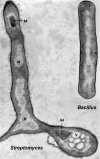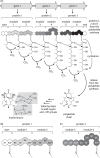Highlights of Streptomyces genetics
- PMID: 31189905
- PMCID: PMC6781119
- DOI: 10.1038/s41437-019-0196-0
Highlights of Streptomyces genetics
Abstract
Sixty years ago, the actinomycetes, which include members of the genus Streptomyces, with their bacterial cellular dimensions but a mycelial growth habit like fungi, were generally regarded as a possible intermediate group, and virtually nothing was known about their genetics. We now know that they are bacteria, but with many original features. Their genome is linear with a unique mode of replication, not circular like those of nearly all other bacteria. They transfer their chromosome from donor to recipient by a conjugation mechanism, but this is radically different from the E. coli paradigm. They have twice as many genes as a typical rod-shaped bacterium like Escherichia coli or Bacillus subtilis, and the genome typically carries 20 or more gene clusters encoding the biosynthesis of antibiotics and other specialised metabolites, only a small proportion of which are expressed under typical laboratory screening conditions. This means that there is a vast number of potentially valuable compounds to be discovered when these 'sleeping' genes are activated. Streptomyces genetics has revolutionised natural product chemistry by facilitating the analysis of novel biosynthetic steps and has led to the ability to engineer novel biosynthetic pathways and hence 'unnatural natural products', with potential to generate lead compounds for use in the struggle to combat the rise of antimicrobial resistance.
Conflict of interest statement
The authors declares that he has no conflict of interest.
Figures





Similar articles
-
Soil to genomics: the Streptomyces chromosome.Annu Rev Genet. 2006;40:1-23. doi: 10.1146/annurev.genet.40.110405.090639. Annu Rev Genet. 2006. PMID: 16761950 Review.
-
[Streptomycetes--producers of polyketide antibiotics].Mikrobiol Z. 2003 Jan-Apr;65(1-2):168-81. Mikrobiol Z. 2003. PMID: 12774508 Review. Ukrainian.
-
Bioactivities and genome insights of a thermotolerant antibiotics-producing Streptomyces sp. TM32 reveal its potentials for novel drug discovery.Microbiologyopen. 2019 Nov;8(11):e842. doi: 10.1002/mbo3.842. Epub 2019 Apr 2. Microbiologyopen. 2019. PMID: 30941917 Free PMC article.
-
Streptomycetes: Surrogate hosts for the genetic manipulation of biosynthetic gene clusters and production of natural products.Biotechnol Adv. 2019 Jan-Feb;37(1):1-20. doi: 10.1016/j.biotechadv.2018.10.003. Epub 2018 Oct 9. Biotechnol Adv. 2019. PMID: 30312648 Free PMC article. Review.
-
Plasticity of the streptomyces genome-evolution and engineering of new antibiotics.Curr Med Chem. 2005;12(14):1697-704. doi: 10.2174/0929867054367176. Curr Med Chem. 2005. PMID: 16022666 Review.
Cited by
-
The Best of Both Worlds-Streptomyces coelicolor and Streptomyces venezuelae as Model Species for Studying Antibiotic Production and Bacterial Multicellular Development.J Bacteriol. 2023 Jul 25;205(7):e0015323. doi: 10.1128/jb.00153-23. Epub 2023 Jun 22. J Bacteriol. 2023. PMID: 37347176 Free PMC article. Review.
-
Genomes and secondary metabolomes of Streptomyces spp. isolated from Leontopodium nivale ssp. alpinum.Front Microbiol. 2024 Jun 14;15:1408479. doi: 10.3389/fmicb.2024.1408479. eCollection 2024. Front Microbiol. 2024. PMID: 38946903 Free PMC article.
-
Comparative Transcriptome-Based Mining of Genes Involved in the Export of Polyether Antibiotics for Titer Improvement.Antibiotics (Basel). 2022 Apr 29;11(5):600. doi: 10.3390/antibiotics11050600. Antibiotics (Basel). 2022. PMID: 35625244 Free PMC article.
-
Streptomyces as a promising biological control agents for plant pathogens.Front Microbiol. 2023 Nov 14;14:1285543. doi: 10.3389/fmicb.2023.1285543. eCollection 2023. Front Microbiol. 2023. PMID: 38033592 Free PMC article. Review.
-
The roles of SARP family regulators involved in secondary metabolism in Streptomyces.Front Microbiol. 2024 Mar 14;15:1368809. doi: 10.3389/fmicb.2024.1368809. eCollection 2024. Front Microbiol. 2024. PMID: 38550856 Free PMC article. Review.
References
-
- Ashley GW, Burlingame M, Desai R, Fu H, Leaf T, Licari PJ, Tran C, et al. Preparation of erythromycin analogs having functional groups at C-15. J Antibiot. 2006;59:392–401. - PubMed
-
- Bedford D, Jacobsen JR, Luo G, Cane DE, Khosla C. A functional chimeric modular polyketide synthase generated by domain replacement. Chem Biol. 1996;3:827–831. - PubMed
-
- Bentley SD, Chater KF, Cerdeño AM, Challis GL, Thomson NR, James KD, Harris DE, et al. Complete genome sequence of the model actinomycete Streptomyces coelicolor A3(2) Nature. 2002;417:141–147. - PubMed
Publication types
MeSH terms
Substances
LinkOut - more resources
Full Text Sources

